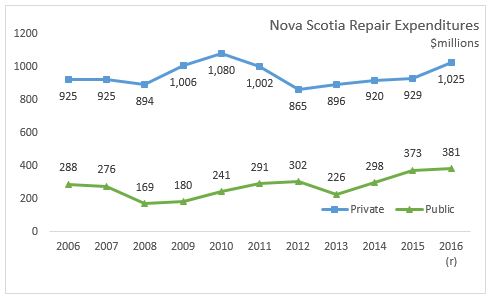The Economics and Statistics Division maintains archives of previous publications for accountability purposes, but makes no updates to keep these documents current with the latest data revisions from Statistics Canada. As a result, information in older documents may not be accurate. Please exercise caution when referring to older documents. For the latest information and historical data, please contact the individual listed to the right.
<--- Return to Archive
For additional information relating to this article, please contact:
February 28, 2018CAPITAL AND REPAIR EXPENDITURES SURVEY, 2017 (PRELIMINARY) AND 2018 (INTENTIONS) Statistics Canada has released the results of its annual survey of capital expenditures for non-residential construction and machinery and equipment. The preliminary estimate for 2017 and intentions for 2018 are based on a sample survey of 25,000 private and public organizations conducted over September 2017 to January 2018.
Capital expenditures include both non-residential capital construction and machinery and equipment spending. After increasing 14.9 per cent in 2016, capital expenditures increased 2.7 per cent in 2017 to $4.091 billion. Growth in 2017 occurred due to increases in private construction (+3.0%) and public machinery and equipment purchases (+93.4%) offsetting declines in private machinery and equipment (-7.5%) and public construction (-1.3%).
Capital expenditure intentions for 2018 are down 8.3 per cent or by $342 million to $3.749 billion. Private construction (-25.0%, -$307 million) is expected to decline while private machinery and equipment spending (3.8%, +$53 million) will increase. Following three years of increases, public capital expenditures is expected to decline 6.1 per cent or $88 million with decreases in construction (-4.6%, -$48 million) and machinery and equipment (-9.7%, -$40 million).

Repair expenditures increased 7.9 per cent in 2016, the third consecutive year of growth. Repair expenditures increased for machinery and equipment (+14.5%) and declined for structures (-4.4%). Repair expenditures increased for private (10.3%) and public (+2.1%).

On an industry basis, the $109 million increase in capital expenditures occurring in 2017 was due to utilities (+$185 million) increasing for a fourth consecutive year. Increases also occurred in educational services (+$103 million), public administration (+$56million), mining, quarrying, oil and gas (+$49 million), information and culture (+$21 million) and construction (+$12 million). Capital expenditures declined in real estate, rental and leasing (-$130 million), wholesale trade (-$83 million), manufacturing (-$32 million), transportation/warehousing (-$30 million), agriculture, forestry and fishing (-$25 million), arts, entertainment and recreation (-$17 million), and retail trade (-$12 million).
For 2018, total capital expenditures are expected to decline by 8.3 per cent or $342 million. The utilities sector (-$249 million) is expected to see the largest decline. Decreases are expected for mining, quarrying, and oil and gas (-$61 million), public administration (-$59 million), transportation/warehousing (-$43 million), educational services (-$26 million), along with smaller decreases in other sectors. The largest increase in capital spending intentions are for real estate, rental and leasing (+$42 million) and retail trade (+$25 million).

Canada is expected to see an increase of 0.8 per cent in capital expenditures in 2018 following on an increase of 3.0 per cent in 2016 and declines in 2014 and 2015. Private capital expenditures are expected to decline 1.1 per cent in 2018 while public capital expenditures will be up 4.1 per cent. Capital spending intentions are down 12 per cent for oil and gas extraction and would be the fourth consecutive annual decline for the subsector. Real estate, rental and leasing sector is projected to rise 9.9 per cent mainly due to Quebec and Ontario. Manufacturing sector capital spending is expected to increase 6.2 per cent led by petroleum and coal products and chemical manufacturing firms. The largest percentage growth will be in Ontario (+7.8%) and Quebec (+5.1%) while Newfoundland and Labrador (-27.8%) and Nova Scotia (-8.3%) are expected to have larger declines.





Capital and Repair Expenditures Survey, 2017 (preliminary) and 2018 (intentions)
<--- Return to Archive